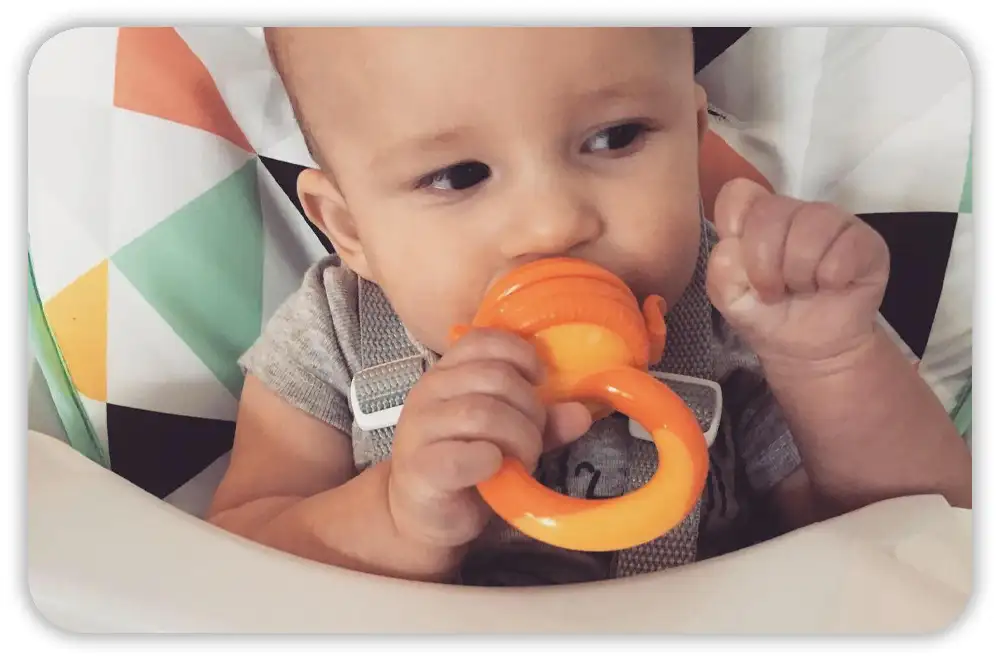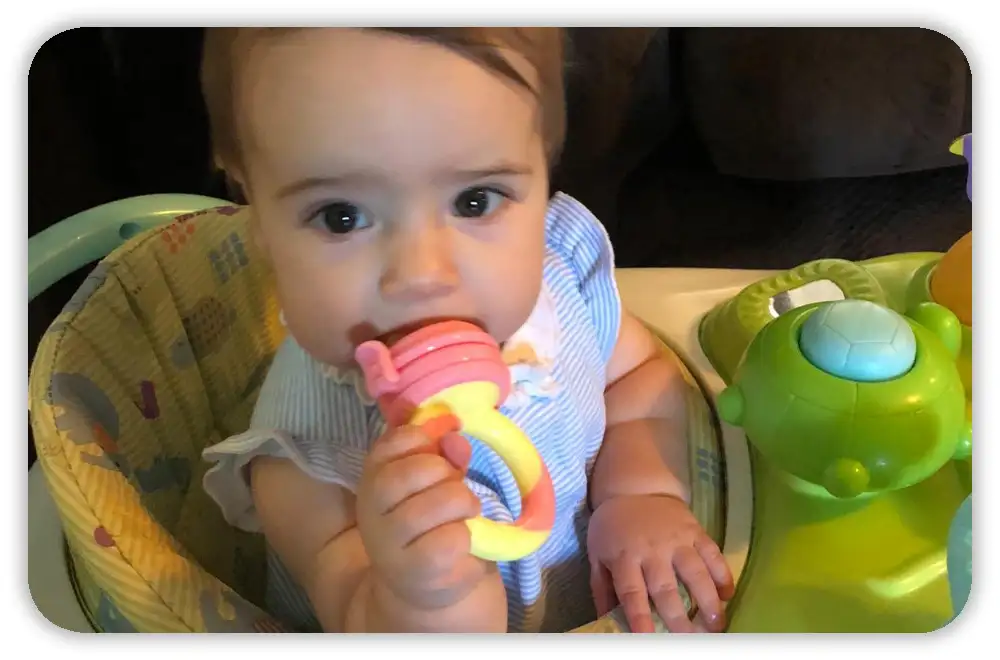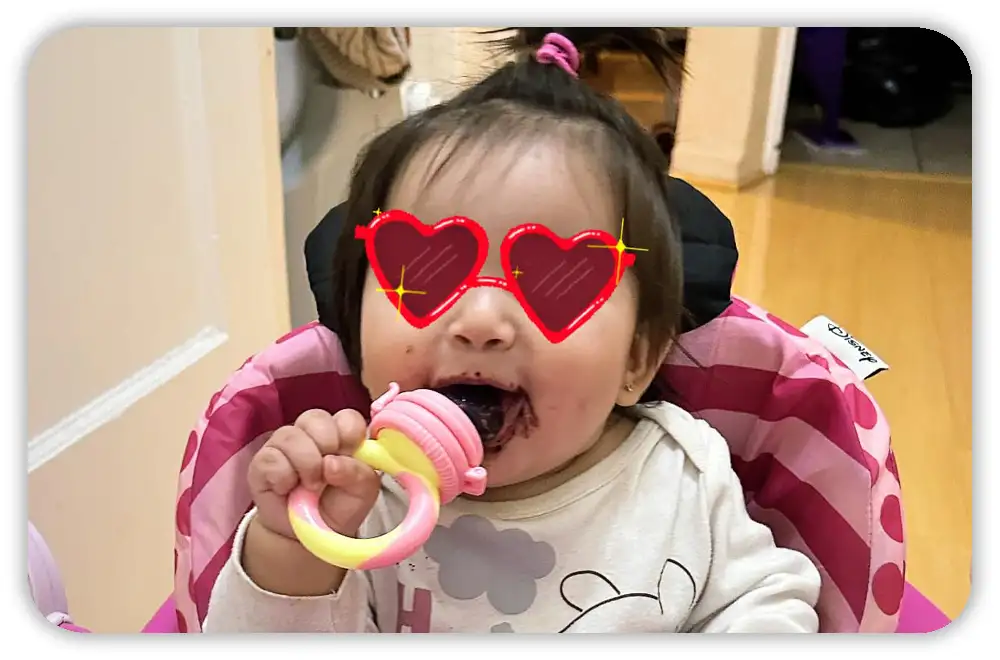If you’ve ever tried giving your baby a slice of peach, you know the mess. Juice on their face, hands, clothes — and somehow even the dog. That’s where the NatureBond Baby Feeder helps. It’s a popular tool for safe baby-led feeding.
It lets little ones explore real food without the choking scares. But here’s what parents ask: Is the NatureBond Baby Feeder worth it, or just another baby gadget? As a mom who has been through the mash, puree, and finger food stages, I’ve tested it in my own kitchen. I’ve seen how it works in real life.
Table of Contents
What Is the NatureBond Baby Feeder?
The NatureBond Baby Feeder is a soft silicone pouch with a handle. It’s made for babies who are starting solids. You put small pieces of fruit, veggies, or even frozen breast milk inside. Your baby chews or sucks on the pouch. This way, they get the flavor and nutrients without big chunks that could cause choking.
In our home, it became a safe way to let my little one try juicy strawberries or ripe mango without me hovering in panic mode. It’s also a lifesaver during teething. A frozen banana inside works better than most teething toys I’ve bought. Many parents also use it with steamed sweet potato or chilled cucumber to soothe gums.
The Pros: Why Parents Love the NatureBond Baby Feeder

From my experience (and from what I’ve heard in mom groups), here’s why it’s a hit:
- Safe for early solids – The soft silicone stops big pieces from getting through. This lowers the choking risk.
- Less mess – Food stays in the pouch, not smeared on clothes or the high chair.
- Great for teething – Fill it with frozen fruit or milk for quick gum relief.
- Easy for small hands – The chunky handle is simple for babies to grip.
- Made with safe materials – BPA-free and food-grade silicone for peace of mind.
I still remember my daughter’s first time using it. She sat in her high chair, gripping the feeder like it was treasure. She happily gnawed on frozen pear for ten whole minutes. She was quiet, content, and completely mess-free. That moment alone made it worth it.
The Cons: Where the NatureBond Falls Short
No baby product is perfect. Here’s where it can be tricky:
- Cleaning can be hard – Pulp can stick in the holes, especially with fruits like oranges.
- Small portion size – You’ll need to refill often if your baby eats a lot.
- Not for all foods – Hard foods like raw apple or carrot don’t break down well inside.
- Some babies lose interest – Once they eat finger foods, they may skip the feeder.
For us, cleaning was the biggest drawback. I once filled it with kiwi, thinking it would be a fun treat. But the tiny seeds got stuck everywhere. It took longer to clean than for her to finish eating. Still, for the right foods and stage, it’s been a solid part of our feeding toolkit.
NatureBond vs. Other Popular Baby Feeders

When I first looked for a baby feeder, I fell into the comparison trap. There are so many brands claiming to be “perfect.” I tried a few, and here’s how NatureBond compares:
| Product | Material | Ease of Cleaning | Best For | Price Range |
| NatureBond Baby Feeder | Soft silicone | Moderate – needs good rinsing | Teething relief, early solids, messy eaters | $$ |
| Boon Pulp Feeder | Silicone with plastic handle | Easier – fewer crevices | Teething babies, simple fruits | $ |
| Haakaa Fresh Food Feeder | Stainless steel + silicone | Easiest – little residue | Babies ready for chunkier textures | $$–$$$ |
In short, NatureBond wins for comfort and safety in early feeding. If cleaning speed matters most, Haakaa is a top choice. Boon works well if you want a low-cost teething helper without extra fuss.
Who Should (and Shouldn’t) Get the NatureBond Feeder
From my kitchen to yours, here’s who will likely love it:
Best for:
- Parents starting baby-led weaning (BLW)
- Babies teething or starting solids
- Caregivers who want less mess and more control
Not ideal if:
- You need to serve big portions fast (the pouch is small)
- You want no extra cleaning after meals
- Your baby already self-feeds solids with ease
If your little one is still exploring textures and you worry about choking, this feeder is a safe middle step between purées and finger foods.
My Personal Verdict: Is the NatureBond Baby Feeder Good?

For me, yes — but with a small warning. It’s a great tool for giving real food without stress. It shines during teething and is one of the few gadgets my daughter used for more than a week.
Still, it’s not magic. You’ll need to clean it well, and it won’t replace a spoon, bowl, or bib. But for safe, independent tasting? NatureBond makes my list of top five baby feeding tools.
Safer or Simpler Alternatives
Not every parent needs the NatureBond, and that’s okay. Here are a few other feeders I’ve used or seen work well:
- Boon Pulp Feeder – Simple design with fewer parts. It’s light, easy for small hands, and great for soft fruits or frozen treats during teething.
- Haakaa Fresh Food Feeder – Made with stainless steel and silicone. Feels sturdy and cleans easily. Best for babies moving to chunkier textures.
- DIY mesh feeders – Sold at most big stores. Cheap and effective, but the mesh can stain and wear out fast.
If you’re not sure which to try, start with a budget option. You can see if your baby enjoys this feeding style before spending more.
Final Thoughts + Takeaway for Parents
Every baby is different. What works for one might get tossed on the floor by another. For us, the NatureBond has been a safe, mom-approved way to start solids without worry. It’s extra helpful for teething days and for keeping the mess under control (most of the time).
If you’re in that exciting but nerve-wracking stage of starting real food, remember—there’s no single “right” tool. The best feeder is the one that fits your baby’s stage, your patience level, and your sink’s tolerance for extra dishes.
FAQs – Is NatureBond Baby Feeder Good?
Is the NatureBond Baby Feeder good for starting solids?
Yes. Its soft silicone pouch lets babies taste food safely without choking. It’s perfect for first bites of fruit or steamed veggies.
Can you put frozen food in a NatureBond Baby Feeder?
Yes. Many parents use frozen fruit or breast milk inside. It soothes teething gums and keeps babies busy.
How do you clean the NatureBond Baby Feeder?
Rinse it right after use. Use a small brush to clear the holes. Cleaning is easier if you avoid foods with seeds that stick.
What age can a baby use the NatureBond Feeder?
Most babies can start at about 6 months. Make sure they can sit up and show interest in food. Always supervise feeding.
Are there better alternatives to the NatureBond Feeder?
It depends. Boon Pulp is easier to clean. Haakaa works well for chunkier textures. NatureBond is best for safe early tasting.

